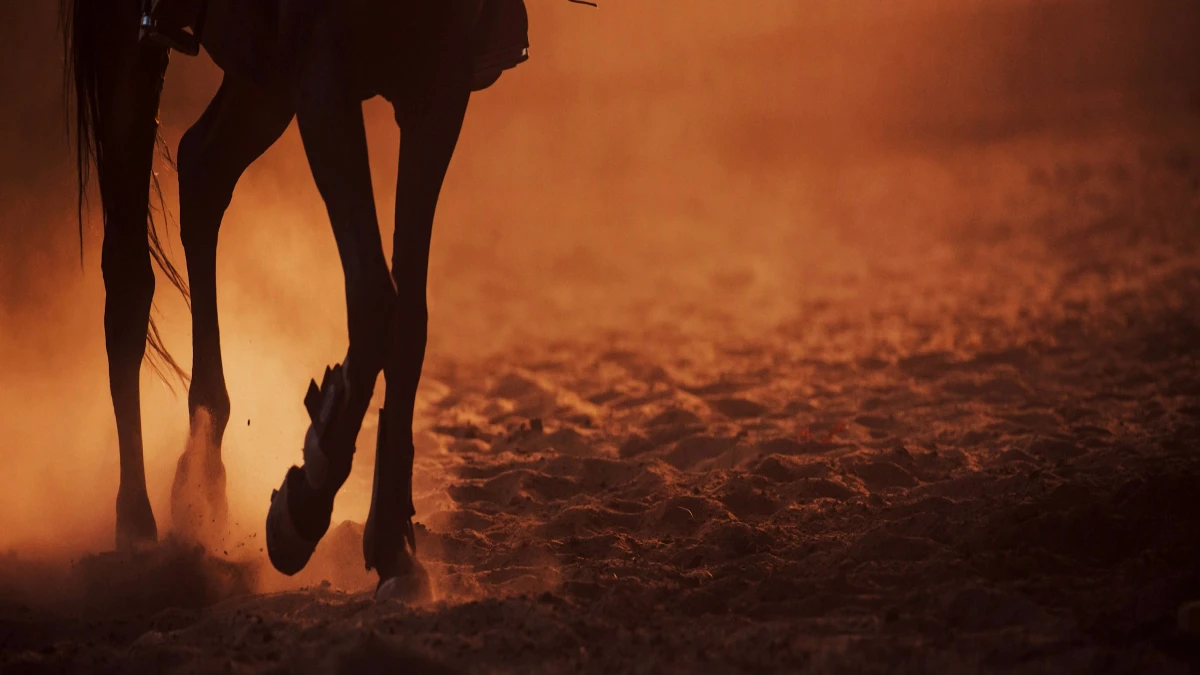Exploring Liberty Work, Bridleless Riding, and Bitless Communication
Aug 7, 2023 by Jamie Finch

In the realm of horsemanship, a unique and captivating journey exists that transcends the conventional boundaries of rider and steed.
It's a journey defined by a profound connection, an extraordinary level of trust, and a language that speaks in whispers of touch and intent.
Welcome to the world of liberty work, bridleless riding, and bitless riding – three distinct horsemanship practices that unveil the art of communication and partnership in ways that challenge tradition and redefine the essence of riding.
Imagine a scenario where a horse and rider move together, bound not by physical restraints but by a bond forged through freedom and respect.
Picture a rider guiding their mount through intricate manoeuvres without traditional reins, relying solely on subtle cues and shared energy.
Envision a horse responding to the gentlest of prompts, navigating the equestrian dance with grace and understanding, all without the presence of a bit.
In exploring advanced horsemanship techniques, I embark on a journey beyond the ordinary that beckons us to push the boundaries of what is possible between horse and rider.
As I delve into the realms of liberty work, bridleless riding, and bitless riding, we will unveil the transformative power of these practices – not just in the realm of horsemanship but in the very essence of the partnership that can be achieved.
Liberty Work
A practice exists that transcends the confines of halters and leads, where the horse is not merely a subject of training but a willing partner in a dance of freedom and trust.
This practice is known as liberty work, a symphony of non-verbal communication and mutual understanding that culminates in a bond unlike any other.
The Essence of Liberty Work
Liberty work is a philosophy that hinges on the belief that true partnership arises when the horse is allowed the freedom to engage without physical constraints.
It embodies a two-way conversation where the horse communicates through gestures, movements, and expressions, and the rider responds with empathy and intuition.
This practice nurtures an environment of trust, respect, and emotional connection that paves the way for a deeper level of horsemanship.
Cultivating Trust through Freedom and Liberty Exercises
Anecdotes abound of horses transformed through liberty work.
Witness a once-aloof equine, hesitant to engage, now choosing to participate willingly in training.
This transformation is further enhanced by incorporating liberty exercises—structured activities performed with a free-roaming horse.
These exercises include:
Leading at Liberty: Guiding the horse without physical contact, encouraging him to follow your cues through body language and energy.
Circle Work: Creating a harmonious partnership as you and your horse move together in circles, exploring various gaits and directions without reins.
Obstacle Negotiation: Collaborating with your horse to navigate obstacles promotes problem-solving and enhances communication.
These exercises create a shared language between horse and rider, forging a powerful connection rooted in mutual respect.
Principles of Liberty Work and Liberty Exercises
Central to the success of liberty work are core principles rooted in non-verbal communication.
The subtle language of body posture, gestures, and energy become the cues that transcend traditional aids.
These principles amplify the understanding between horse and rider in synergy with liberty exercises.
The exercises serve as stepping stones, strengthening the horse's responsiveness and fostering a deep bond of trust.
Beginning the Liberty Journey and Exploring Liberty Exercises
The initial steps involve creating a safe and inviting environment for those eager to embark on the liberty journey.
Introduce the horse to the concept of liberty through gradual exercises that emphasize communication without physical restraints.
Liberty exercises, interwoven into this journey, act as bridges between groundwork and fully liberated communication.
As the horse and rider learn to converse through nuanced cues, they embark on a transformative path toward a partnership founded on freedom and trust.
In the realm of liberty work, the horse becomes not only a willing participant but a co-creator in the journey of horsemanship.
The magic lies in the freedom to express, the power to choose, and the beauty of understanding that arises from a language spoken beyond words.
Bridleless Riding
As I venture further into advanced horsemanship, I encounter the captivating art of bridleless riding—an eloquent dance where communication transcends reins and bridles, and the rider's touch becomes a symphony of connection.
Unveiling Bridleless Riding
Bridleless riding is a testament to the depth of partnership achievable between horse and rider.
It's a journey that requires a profound understanding of equine behaviour, a mastery of subtle cues, and an unwavering bond built upon mutual trust and respect.
In the absence of traditional tack, the horse and rider engage in a dialogue that goes beyond physical aids, elevating their communication to a level of nuance that reflects a shared language of touch, energy, and intention.
Building the Foundations for Bridleless Riding
A strong foundation rooted in classical training and groundwork is imperative before embarking on bridleless riding.
Groundwork establishes the groundwork (pun intended) for a harmonious relationship.
Classical training principles refine the horse's responsiveness to rider cues, preparing them to transition to a bridleless experience seamlessly. As reins fade away, the rider's seat, legs, and balance become the primary communication channels, subtly guiding the horse through an intricate choreography of movement.
Mastering Independent Aids
The art of bridleless riding hinges on the mastery of independent aids—rider cues that guide the horse with precision and subtlety.
The rider's seat communicates rhythm, pace, and balance; legs convey direction and impulsion; weight aids signify transitions and shifts.
The fusion of these aids paints a vivid picture of unity as horse and rider communicate through an unspoken dialogue.
Each movement is a testament to their connection and the hours of dedicated practice and unwavering trust.
Showcasing Bridleless Riding Maneuvers
Bridleless riding is not merely about forward motion but finesse, control, and the ability to execute complex manoeuvres.
Witness the grace of a horse executing a collected canter, guided solely by the subtlety of the rider's cues.
Observe the precision of lateral movements, the elegance of spins, and the harmony of lead changes, all achieved without the constraints of traditional tack.
It's a testament to the partnership that bridleless riding fosters and the endless possibilities when communication knows no bounds.
Bitless Riding
In the symphony of advanced horsemanship, bitless riding emerges as a harmonious melody, emphasizing the subtlety of communication and the gentle exchange of cues between horse and rider.
As I delve into this art, I discover how bitless riding enriches the partnership, creating a canvas of understanding and cooperation.
Embracing Bitless Riding
Bitless riding extends the principles that underscore liberty work and bridleless riding.
It celebrates the concept of cooperation and communication through gentleness rather than force.
Removing the traditional bit, the rider shifts the focus to responsive cues and the horse's willingness to engage.
The result is a harmonious dialogue between two beings, united by trust and guided by a shared intention.
The Gentle Dynamics of Bitless Riding
Step into the world of bitless riding and witness the transformative effect on both horse and rider.
The absence of a bit fosters a deeper sense of unity as the horse responds to subtle signals from the rider's hands, seat, and legs.
This gentle approach cultivates a relationship built on mutual respect, where the horse's natural movements and expressions are honoured, leading to a more serene and cooperative ride.
Transitioning to Bitless Riding
A thoughtful transition is key for those intrigued by bitless riding.
Begin by selecting a suitable bitless bridle that complements your horse's conformation and temperament.
Introduce the concept gradually, allowing your horse to adapt to the change.
Through patience and understanding, the transition becomes a seamless evolution that embraces the spirit of collaboration and respect.
Conclusion
I've embarked on a journey of transformation and connection in our expedition through liberty work, bridleless, and bitless riding.
Each practice has unveiled a unique facet of the profound partnership between horse and rider, inviting you to rethink the boundaries of traditional horsemanship.
The art of liberty work shows that true understanding blooms when we give the horse the canvas of freedom.
Through liberty exercises, we've painted a portrait of communication that surpasses the spoken word, creating a harmonious language of gestures and energy.
Bridleless riding has allowed you to transcend the constraints of reins and discover a realm where touch becomes the eloquent means of dialogue. The dance of independent aids has empowered us to guide our equine companions with the gentlest cues, proving that unity knows no bounds.
With bitless riding, I've entered a realm of sensitivity and cooperation where communication thrives without needing a bit.
I've cultivated a deeper trust and shared understanding as I've explored these gentle dynamics.
As I conclude this exploration, you stand at the threshold of horsemanship's uncharted territories.
Armed with the wisdom of liberty work, the finesse of bridleless riding, and the empathy of bitless riding, you're poised to continue your journey, embracing the ever-evolving connection with your equine partners.
Explore More Topics
Understanding Behavioural Changes in Horses
When a horse’s behaviour suddenly changes, it’s rarely without cause. This blog explores the physical, emotional, and environmental reasons behind behavioural shifts — and how owners can respond with understanding, clarity, and care.
May 31, 2025
10 Essential Groundwork Exercises to Improve Equine Agility
This blog post, "10 Essential Groundwork Exercises to Improve Equine Agility," provides a comprehensive guide for horse owners looking to enhance their horse's agility, coordination, and responsiveness through progressive groundwork. Each exercise includes step-by-step instructions, explains why the exercise is important for building trust, focus, and physical conditioning, and details how these skills translate into improved performance in agility courses and other equestrian pursuits.
Oct 28, 2024
Top Tips for First-Time Horse Owners: How Equine Insurance Can Give You Peace of Mind
Equine insurance is a crucial safety net for horse owners, providing financial protection against unexpected costs related to veterinary care, accidents, injuries, and liability claims. Whether you're a first-time owner or an experienced equestrian, insuring your horse offers peace of mind by covering expensive vet bills, public liability issues, theft, and even death.
Oct 23, 2024







